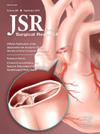专家与新手在机器人直肠切除术中的客观表现指标不同
IF 1.8
3区 医学
Q2 SURGERY
引用次数: 0
摘要
客观性能指标(opi)是基于机器人系统数据计算的机器学习指标,有可能为外科手术技能提供客观的见解。关于opi在结直肠手术中的应用的研究有限。在这项研究中,我们的目的是确定不同的专家和新手外科医生在机器人直肠切除术(RP)。方法对与机器人系统数据同步的内镜视频进行注释,以描绘30次rp期间的单个手术任务。我们分析了541个关键步骤:肠系膜下动脉清扫(78),乙状结肠清扫(167),直肠后清扫(88)和肠系膜清扫(208)。每个步骤的opi在两名专家(500个机器人手术)和11名新手外科医生(50个手术)之间进行比较。结果专家外科医生与新手外科医生的opis分析结果存在显著差异。在所有的步骤中,专家们都表现出了更高的速度和加速度,无论是主臂还是非主臂。在肠系膜动脉夹层中,专家使用较少的手臂交换和较长的能量激活时间。在乙状结肠活动期间,专家使用更少的手臂交换、更短的相机移动时间、更少的相机运动和更少的主手腕俯仰。在直肠活动和直肠系膜剥离过程中,专家表现出更大的优势手腕关节(滚动、俯仰和偏航),以及更长的相机路径长度,优势和非优势手臂。这些结果确定了RP期间指定外科医生专业知识的特定opi。结论专家外科医生与新手外科医生在RP手术中的步特异性OPIs有显著差异。通过进一步验证,这些指标可以作为基准性能的客观工具,指导外科培训课程,并通知认证过程。本文章由计算机程序翻译,如有差异,请以英文原文为准。
Objective Performance Indicators Differ Between Expert Versus Novice Surgeons During Robotic Proctectomy
Introduction
Objective performance indicators (OPIs), machine learning-enabled metrics calculated from robotic systems data, have potential to offer objective insights into surgical skill. There are limited studies investigating OPIs in colorectal surgery. In this study, we aim to identify OPIs that differ expert and novice surgeons during robotic proctectomy (RP).
Methods
Endoscopic videos synchronized to robotic system data were annotated to delineate individual surgical tasks during 30 RPs. We analyzed 541 critical steps: inferior mesenteric artery dissection (78), sigmoid mobilization (167), posterior rectal mobilization (88), and mesorectal dissection (208). OPIs from each step were compared across two expert (>500 robotic procedures) and eleven novice surgeons (<50 procedures).
Results
OPIs analyses revealed significant differences between expert and novice surgeons. Across all steps, experts exhibited greater velocity and acceleration for camera, dominant and nondominant arms. During mesenteric artery dissection, experts utilized fewer arm swaps and longer energy activation time. During sigmoid mobilization, experts used fewer arm swaps, shorter camera moving time, fewer camera movements, and less dominant wrist pitch. During rectal mobilization and mesorectal dissection, experts exhibited greater dominant wrist articulation (roll, pitch, and yaw), and longer path length for camera, dominant and nondominant arms. These results identify specific OPIs that designate surgeon expertise during RP.
Conclusions
Step-specific OPIs significantly differ between expert and novice surgeons during RP. With further validation, these metrics may serve as objective tools for benchmarking performance, guiding surgical training curricula, and informing credentialing processes.
求助全文
通过发布文献求助,成功后即可免费获取论文全文。
去求助
来源期刊
CiteScore
3.90
自引率
4.50%
发文量
627
审稿时长
138 days
期刊介绍:
The Journal of Surgical Research: Clinical and Laboratory Investigation publishes original articles concerned with clinical and laboratory investigations relevant to surgical practice and teaching. The journal emphasizes reports of clinical investigations or fundamental research bearing directly on surgical management that will be of general interest to a broad range of surgeons and surgical researchers. The articles presented need not have been the products of surgeons or of surgical laboratories.
The Journal of Surgical Research also features review articles and special articles relating to educational, research, or social issues of interest to the academic surgical community.

 求助内容:
求助内容: 应助结果提醒方式:
应助结果提醒方式:


